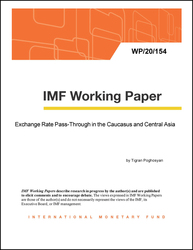
Exchange Rate Pass-Through in the Caucasus and Central Asia
Exchange Rate Pass-Through in the Caucasus and Central Asia
READ MORE...
Volume/Issue:
Volume 2020
Issue 154
Publication date: August 2020
ISBN: 9781513552958
$18.00
Add to Cart by clicking price of the language and format you'd like to purchase
Available Languages and Formats
| English |
Prices in red indicate formats that are not yet available but are forthcoming.
Topics covered in this book
This title contains information about the following subjects.
Click on a subject if you would like to see other titles with the same subjects.
Inflation , WP , confidence interval , CPI inflation , CCA country , inflation environment , currency vis-à-vis , IMF staff estimation , Exchange rates , Exchange rate adjustments , Exchange rate pass-through , Exchange rate arrangements , Inflation , Global , Sub-Saharan Africa , Central Asia and the Caucasus , exchange rate regime , local projections , pass-through in CIS country
Summary
This paper estimates the extent and speed of exchange rate pass-through (ERPT) in seven Caucasus and Central Asia (CCA) countries using monthly data over the January 1995–May 2020 period. The estimations are performed using the local projections method. We find that the average pass-through in the CCA is about 10 percent on impact and about 25 percent after 12 months. There is no evidence of asymmetric ERPT with respect to the size and the sign of exchange rate changes. The pass-through is broadly unchanged in fixed versus floating exchange rate regimes. There has been a downward shift in the speed of ERPT in the aftermath of the global financial crisis as CCA countries have entered a relatively low inflation environment. The pass-through estimates could be used by the CCA monetary authorities for inflation projections. The absence of non-linearities in the pass-through with respect to the exchange rate regime suggests that transition from fixed to floating exchange rate regimes in the region is not likely to impose additional inflationary costs.
Copyright © 2010 - 2025
Powered by:
AIDC



